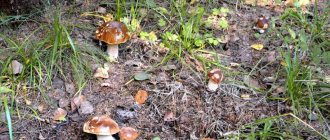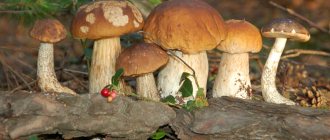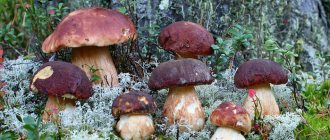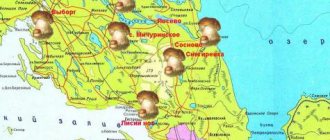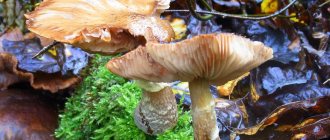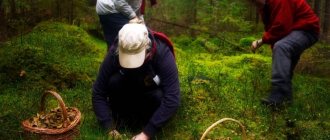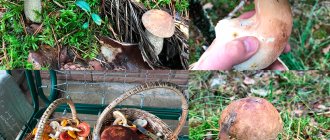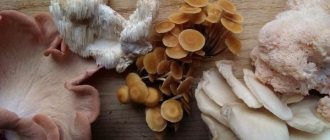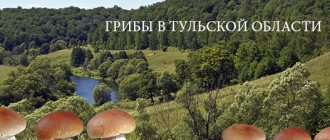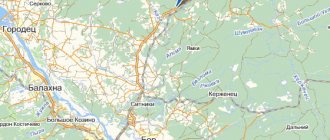With the onset of mushroom weather, many lovers of quiet hunting are increasingly wondering whether there are mushrooms in the Leningrad region in 2022. Not wanting to waste their free time in vain, local residents are trying to find out all the information about the beginning of the season using social networks and forums before going into the forest in search of edible prey. In VKontakte groups created according to interests, people increasingly began to boast about the trophies they collected. However, if beginners can, out of ignorance, tell where they collected a good harvest, experienced mushroom pickers living in the Leningrad region will never reveal their coordinates. That is why we decided to help our readers decide on collecting places by demonstrating not only a mushroom map, but also suggesting landmarks for “mushroom pantries”.
The article below contains only useful information, photos and recommendations that will simplify the task of every mushroom picker.
Mushroom places in the Leningrad region 2022 now
If 100 years ago it was safe to pick mushrooms, in our time, due to the large number of cars, city landfills, factories that illegally throw away processed raw materials and polluted water bodies, a product with a high protein content can cause irreparable harm to health. We are talking about edible, not poisonous fruits that tend to absorb toxins into their pulp. So, the once quite tasty pig has been reclassified as a mushroom not recommended for picking...
In order not to harm yourself and the health of your loved ones, you should go in search of mushrooms only in places that have been proven over the years. Then, poisoning and intoxication of the body will not be scary!
The list of the most popular mushroom places in the Leningrad region includes:
1) In search of boletus, saffron milk mushrooms, spruce mushrooms and milk mushrooms, you can go to the pine forest located in the Piozersky district. You can get to the place by private car, heading towards the Vyborg highway.
2) In second place in popularity remains the pine forest, located within the village of Sosnova. You can find mushrooms there not only in September and October, but also in the off-season. The most convenient way to go hunting in that area is by train, sitting at the Finnish station in St. Petersburg.
3) The third place in the list of mushroom places is occupied by dense pine plantings located in the Vsevolozhsk region. Having decided to go there, the mushroom picker will have to travel not a lot - not a little, but about 115 kilometers. The distance may vary depending on the starting point. For those who do not know the area, it is better to take a smartphone with a navigator on the road so as not to get lost.
4) In the middle of the list was the village of Kirillovskoye, famous for its unique forest landscapes. The rich “green” area allows you to collect not only mushrooms, but also berries, medicinal plants and even pine cones.
5) Fifth place in 2022 is shared by two places that are not close to each other. We are talking about the Luga and Zakhodsky districts. Mixed forests allow you to collect not only mushrooms sprouting in the coniferous forest, but also in the deciduous zone. As many say, no one left without white, Polish and autumn honey mushrooms during the peak season.
And again, conspiracy theorists fantasized...
Since ancient times, people have been studying the properties of mushrooms. To this day, these amazing organisms are not fully understood. There are two inexplicable but proven facts about mushrooms:
- Having incredible energy. Science knows mushrooms that can break up asphalt, absorb radiation and change their shape in a very short period of time.
- Influence on people's consciousness. There are no other plants in living nature that can change the biochemistry of the brain so strongly. That is, to have a pronounced psychedelic effect.
This leads to an interesting hypothesis about the extraterrestrial origin of the organisms in question.
Where to look for conditional and edible mushrooms?
Silent hunting in the Leningrad region is not limited to the above mentioned gathering places. Subject to all safety rules, local residents can look for mushrooms in other places, following the map of the region. The most important thing is not to count on a good harvest of noble mushrooms in the coniferous forest and trophies in the form of boletus and saffron milk caps in the oak forests. Each mycelium sprouts where it belongs. Don't count on a unique case!
Beginners are not recommended to go mushroom hunting alone. Ignorance of the distinguishing signs can lead to tragedy. Therefore, if you study the basics of quiet hunting, then only with an experienced person who has been collecting conditional and edible gifts of the forest for several years.
Important!
To return home with baskets full of mushrooms, you must follow three simple rules. First, it is better to go for valuable fruits during the peak season (August, September, October), when the weather outside is warm, rainy, but not hot. Second, it’s better to go earlier during the week, rather than on a weekend. This will increase the chance of searches by reducing the number of competitors. Well, the third and final rule: do not look for your favorite mushrooms out of season.
Mushroom picker calendar for 2021
Mushroom pickers have their own secrets, which they pass on from generation to generation. The phases of the moon are believed to influence the growth of mushrooms. So, you should go into the forest in search of them when the harvest is growing, and when it is decreasing, you should process the previously collected crop. Mushrooms stored for the winter when the moon wanes will be stored longer and less susceptible to souring.
On a note!
During the 2022 harvesting season, the moon will wax from July 11 to 23, August 10 to 20, and September 9 to 21. These months are the peak of the mushroom season. Boletuses, white mushrooms, champignons, russula, saffron milk caps, boletus and milk mushrooms grow.
What do they write on the forum? Have the mushrooms gone or not?
As in previous years, residents of the Leningrad region on the forum discuss only common mushrooms that grew this year. Less often, they complain about poorly fruiting breeds. The list of the most popular forest gifts included:
- summer and autumn honey mushrooms;
- boletuses (boletus and boletus);
- boletus;
- Polish mushrooms;
- oyster mushrooms;
- lines and morels;
- waves;
- milk mushrooms;
- rows;
- boletus;
- saffron milk caps;
- umbrellas, or as they are also popularly called, priests;
- chanterelles;
- dung beetles;
- Russula.
Gourmets who have learned to look for delicacy species are discussing truffles on the Leningrad Region forum. Expensive mushrooms are worth their weight in gold to mushroom pickers. True, in order to find at least one such trophy, you need not only to be able to distinguish edible fruits from false ones, but also to have a dog trained to find mushrooms by smell.
As in other regions of Russia, duplicates of edible breeds are found in the Leningrad region. You should be especially careful with fly agarics, false honey mushrooms, yellowing champignons and toadstools. They should be avoided!
Description of the region's mushrooms
Mushroom pickers in the Leningrad region collect the following types of edible mushrooms: morels, porcini mushrooms, truffles, oyster mushrooms, veselka, chanterelles, boletus, boletus, honey mushrooms.
Inedible hallucogenic species are also found in the forests: psilocybin varieties, toadstools, false honey mushrooms, fly agarics, yellow champignon, string.
Morel
The first edible mushrooms of spring are morels. Appear in mixed forests in April-May. The mushroom cap is conical, wrinkled.
Leg length up to 10 cm. Color white. In terms of taste, it is second only to porcini mushrooms and boletus. The mushroom is used to prepare various culinary delights.
Porcini
Porcini mushrooms in the Leningrad region are collected from July to September. They grow in a pine forest, on sandstones. The shape of the cap is round. The color is gray, the leg is dense and thick.
The edibility of a mushroom can be determined by its pleasant aroma. The false porcini mushroom or toadstool has a sulfuric acid smell. Porcini mushrooms can be used for preparing any culinary dishes, pickling, marinating, but they are especially good in dried form, when the aroma reaches its climax and is simply dizzying.
Truffles
Truffles grow at a depth of 15 cm
The Leningrad region is one of the few regions of Russia where white truffle grows. To collect it, you will need a trained pig or dog.
Collecting truffles is complicated by their underground origin. They grow at a depth of 15 cm, so it is difficult to find them. Always remember the place where the truffles were dug up; next year they will grow there again if you are careful when collecting them and do not damage the mycelial hyphae. Knowledgeable mushroom pickers keep the distribution areas of this species a secret, since a bag of underground mushrooms can bring income equal to the average monthly salary.
In appearance, the truffle resembles a wrinkled apple or white quince. The ball has a dense structure.
Oyster mushrooms
The oyster mushroom harvest season begins in September and continues until frost. Edible mushrooms have been praised for their low calorie content. The cap is curved at the edges, its shape resembles a shell, its diameter in an adult specimen reaches 25 cm. The color ranges from milky to purple. The leg is thin, 2-3 cm high.
The pulp is juicy, dense structure. Grows on dead trees and stumps. Suitable for preparing appetizers, first courses and side dishes.
Veselka
Grows solitarily in mixed and coniferous forests. Peak fruiting occurs in August. The mycelium does not form in one place for several years.
It is used to make medicines for a wide variety of diseases. They find it by its putrid smell. The cap and leg are covered with mucus. The most valuable mushroom is considered to be in the “egg” stage, filled from the inside with a jelly-like liquid.
Irina Selyutina (Biologist):
Although you can collect common veselka, or samotnik, from May to October, August is considered the best time. It is at this time that the peak activity of mycelium is observed in terms of the formation of young fruiting bodies. This means it will be easier to find them.
For searching, you should choose sunny weather, but do not forget that the “devil’s egg,” like other mushrooms, loves rain and it is after rain that they will begin to grow in wet weather.
When collecting the “eggs,” you need to carefully dig them out with your hands or a small spatula (you can confiscate a child’s scoop). If the mushroom has just begun to “hatch”, cut it off or pick it. However, despite the same spectrum of action, preference is usually given to the underground “egg”. It is better to collect them in a wide container covered with a soft cloth so as not to damage them when carried.
Based on their feeding method, Veselka belongs to the group of soil saprophytes-gasteromycetes. There is an assumption that, depending on the growing conditions, the veselka can also be a mycorrhiza-former with beech, oak and some shrubs, under which it is most often found, as well as a parasite of grapevines and rose bushes.
Chanterelles
Delicious edible mushrooms. The surface of the cap is concave, resembling a funnel, along the edges there are waves wrapped towards the stem. The older the specimen, the more the shape of the cap begins to resemble a funnel. The pulp has a compact structure, not brittle. It has a pleasant aroma and high taste.
Representatives of this species love pine forests. Fruiting bodies are formed in early summer and grow until mid-October. You should look for them in open areas, under grass and leaves. Used for making pickles and various culinary dishes. The main advantage that mushroom pickers value in chanterelles is that they do not become wormy. This is due to the presence in their pulp of a special natural compound - quinomannose.
Butter
Mushrooms are common in mixed and coniferous forests. If you find one, it means there is a whole group nearby. The mushroom cap is semi-conical, about 15 cm in diameter. Covered with an oily brown skin.
The leg is dense, about 8 cm. Painted white. The pulp has a dense structure, sponge-like. Has a pleasant aroma of pine needles. The product is used for frying, boiling, salting and drying. The fruiting season begins in May-June and ends in September-October.
Boletus
Boletus is universal in use
The name itself speaks about the habitat of the mushroom. The cap is hemispherical, bright orange-brown. In adult specimens, its diameter can reach 30 cm. In the village of Sosnovo, Priozersk region, you can collect 10-20 kg of boletuses in one trip.
The leg is dense, large, covered with small brown scales. The pulp has a fibrous structure. Refers to universal products in terms of use. When fried, it tastes like meat.
Honey mushrooms
They have a pleasant taste and aroma. They settle on stumps. The cap is convex, and with age its edge becomes wavy. Average size 12 cm.
The leg has a fibrous structure. Thin, long - 10 cm, widened at the top. The pulp is white, fibrous. Autumn boletus actively bears fruit throughout September.
The color of the cap depends on the type of wood on which the mushroom has settled. Acacia or poplar produce honey-yellow tones. The oak is red, and the pine deadwood is brown-red.
Map in photo
If you want to pick mushrooms in the Leningrad region 2022, you should pay attention to such places on the map as:
1) the village of Sosnovo, characterized by mixed plantings;
2) Priozersky district;
3) the territory adjacent to Lake Zerkalnoye, located in the Vyborg region; 4) the villages of Kolchanov and Chernoushevo;
5) Karelian Isthmus;
6) the village of Losevo, rich in porcini mushrooms, mushrooms and moss mushrooms;
7) you can take a minibus to Kingisepp. There are a lot of chanterelles, monkeys and boletus.
There are quite a few mushrooms in the village of Berngardovka. You can get to the place in 30 minutes by taking a minibus from the Finnish station;
9) the most mushrooms can be found in the village of Novoe Dyatkino. A real assortment of mushrooms sprouts there, from noble species to conditionally edible mushrooms that require careful cleaning and boiling;
10) in last place is the village of Sinyavino. There, deep in the coniferous forest, you can find boletus, chanterelles and podgruzki.
Delicacy for gourmets
We simply do not have the right to ignore any mushroom dish. Let's tell you the recipe for a simple but incredibly mouth-watering delicacy.
So you returned from nature with a basket of boletus mushrooms, there is nothing special to eat at home, and hunger has been tormenting you for more than one hour... Right now you can turn a small part of the catch into a hearty dish that will satisfy your hunger for the rest of the day... So, the recipe! Required ingredients:
- White mushrooms;
- salt;
- onion;
- butter.
Carefully wash 5-6 young boletus mushrooms. Dry them with a napkin and cut them into medium-sized slices.
Melt the butter in a frying pan. Finely chop the onion and add it to fry. The whole trick is to prevent the onions from burning, but to form a viscous substance together with the butter. When this metamorphosis has occurred, add chopped mushrooms to the onions. Simmer for 10 minutes over medium heat, then add salt to the dish. Next, simmer over low heat until done. Place on a plate.
If you find any summer greens in the refrigerator, chop them finely and sprinkle on the dish. Bon appetit!
Video + reviews
After reading real reviews on mushroom picking forums and watching videos posted by famous bloggers, we can conclude that not a single person living in the Leningrad region will leave the forest without mushrooms. By choosing the right place and following the recommendations given in the article, anyone who knows the distinctive features of edible mushrooms will be able to collect a lot of tasty and healthy mushrooms.
Mushrooms in the Leningrad region 2022 will always attract the attention of both experienced mushroom pickers and beginners. With such a rich harvest, mushrooms will never be eliminated.
Poisonous mushrooms
The genus Psilocybe of the Strophariaceae family has about 150 species. Its representatives are poisonous mushrooms that have a hallucinogenic effect. When used for the first time, there are no obvious consequences. Long-term systematic consumption of these mushrooms causes persistent mental disorders.
They grow on stumps and next to them. The cap is cone-shaped, the stem is thin. Painted grey. The toadstools are the very first to appear. If you want to collect a lot of mushrooms, focus on their location; edible species will definitely grow nearby. The toadstool's cap is cone-shaped and pink.
Fly agarics live in forests of any type and are poisonous. They cannot be confused with anything. White dots clearly appear on the red caps. The leg is tall and white. The habitat of poisonous mushrooms is similar to their edible counterparts. The legs are thin, hollow, the caps are brightly colored. The skin is smooth.
Yellow champignons are poisonous mushrooms. The cap is white, turning bright yellow when squeezed. Consumption of this variety leads to serious poisoning. If dizziness, vomiting, or loss of consciousness occurs after eating mushrooms, you should immediately see a doctor.
Strings are the poisonous counterparts of morels. Their cap is shapeless, wrinkled, attached to the stem along its entire length. The pulp is light, fragile, without a pronounced odor.
Irina Selyutina (Biologist):
The lines have a number of characteristics that make it easy to learn to distinguish them from edible morels, especially if you also look at the picture depicting their appearance:
- Cap: its surface resembles the kernel of a walnut or a human brain.
- The shape of the cap: resembles a crumpled ball of paper, irregular.
- Leg: goes into the ground or forest floor, wide, can be hidden by the cap.
- Apothecium cavity: filled with convoluted pulp.
- Smell: very weak.
The season of increased fruiting begins in parallel with morels.
Interesting Facts
There are many fascinating stories associated with mushrooms, but we will focus on the most useful ones for those who like to collect them. Go:
- Should I twist or cut the mushroom? Which is correct? Both methods are acceptable. Scientists have come to the conclusion that carefully twisting the mushroom does not cause any harm to the mycelium.
- Some fly agarics are not only edible, but also very tasty! The gray-pink representative of this family is edible. You can find it in the summer, in tall, spiky grass. You should take young and fresh-looking fly agarics. Before frying, these mushrooms will have to be boiled and drained.
- Russula and porcini mushrooms can be eaten raw. The name of the first mushroom already suggests that it can be eaten just like that. The second one generally has an excellent taste (slightly sweet). There is always something to eat in the forest!
- Chanterelles are the enemies of parasites. Inside this red mushroom contains a substance that destroys helminths outright. Eating chanterelles is the best prevention against parasites.
- Glowing mushrooms. I'm not kidding! Some forest gifts glow fantastically in the darkness of the night. Science knows of rare species that shimmer with an alluring green-yellow light. It looks like there are light bulbs inside them.
Fungi are unique organisms. And the process of collecting them is a protracted affair. It is worth remembering: interesting mushrooms love logical search and extraordinary solutions. He who seeks will always find. Good luck!
